It is best to grow seedlings in separate cups; this will make further transplanting into open ground much easier. If the seedlings are planted in a common box, then you need to try to transplant them onto the site as carefully as possible.
|
If the roots are strongly intertwined, the seedlings can be dipped in water, then separate the roots, being careful not to tear them off. |
We take care of the roots when transplanting.
A common box for seedlings has a significant drawback - in it the roots of the seedlings are intertwined with each other, which does not happen in cups. Such seedlings must be removed, being careful not to damage the roots. The slightest injury to them will lead to the fact that after transplantation the plant will begin to restore the root system, which will result in a lag in growth and development. And as a result, the yield from such plants will not be high.
If, nevertheless, the seedlings are planted in a common box, then before removing them it is necessary to water the soil so that it turns into mud. Then you can start removing the seedlings with a spatula.
Plants removed from the ground must be transplanted into the ground as quickly as possible. To do this, planting holes are prepared in advance; in this case, after removing the seedlings from a cup or box, the roots will not have time to dry before planting them in the ground.
Seedlings from cups are planted in holes along with a lump of earth, so the plant will take root faster and begin to grow. It is very convenient to use peat pots, which can be planted in the ground along with seedlings. This cup dissolves in the soil, and the roots receive additional nutrition. Such cups are more expensive than plastic ones and can only be used once, but they provide much more benefits.
Landing depth.
When planting seedlings, great attention should be paid to planting depth. Not all plants like deep planting. For example, tomatoes and cabbage can be planted deep. New roots begin to appear on their buried stem, which allows them to receive even more nutrition, and therefore a richer harvest.
But peppers and eggplants are opponents of deep planting. They need to be planted at the same depth at which they grew, otherwise there will be a noticeable lag in growth and even the death of the plant.
After planting the seedlings, the soil must be compacted; there should be no voids between the soil and the roots.
Number of plants per square meter.
When planting seedlings, it is important to correctly determine the number of plants per unit area. If the number of plants is small, this will lead to a small harvest. If a lot of plants are planted, they will lag behind in development, and this will lead to a decrease in yield. And also in areas where seedlings are planted, fungal diseases often form. This is due to the fact that the earth is not blown by the wind, moisture does not evaporate and a favorable environment is formed for the development of fungi.
So, what is the optimal number of seedlings per square meter:
- white cabbage - five to six pieces;
- tomatoes - three or four pieces;
- eggplants - eight pieces;
- pepper – twelve pieces;
- zucchini - three pieces;
- cucumbers - about ten pieces.
Disembarkation dates.
Each crop has its own planting dates; they are determined by resistance to cold and the timing of crop ripening.
- In the twentieth of April, seedlings of white cabbage, cauliflower and broccoli can be planted in open ground.
- Ten days later, lettuce, rutabaga, celery, and vegetable physalis are planted.
- By the end of May they begin planting eggplants, pumpkins, zucchini, cucumbers, and tomatoes.
- In early June, watermelon, melon, and beans are planted.


 (1 ratings, average: 4,00 out of 5)
(1 ratings, average: 4,00 out of 5) CUCUMBERS NEVER GET SICK, I'VE BEEN USING ONLY THIS FOR 40 YEARS! I SHARE A SECRET WITH YOU, CUCUMBERS ARE LIKE THE PICTURE!
CUCUMBERS NEVER GET SICK, I'VE BEEN USING ONLY THIS FOR 40 YEARS! I SHARE A SECRET WITH YOU, CUCUMBERS ARE LIKE THE PICTURE! You can dig a bucket of potatoes from each bush. Do you think these are fairy tales? Watch the video
You can dig a bucket of potatoes from each bush. Do you think these are fairy tales? Watch the video
 How our fellow gardeners work in Korea. There is a lot to learn and just fun to watch.
How our fellow gardeners work in Korea. There is a lot to learn and just fun to watch. Eye trainer. The author claims that with daily viewing, vision is restored. They don't charge money for views.
Eye trainer. The author claims that with daily viewing, vision is restored. They don't charge money for views. A 3-ingredient cake recipe in 30 minutes is better than Napoleon. Simple and very tasty.
A 3-ingredient cake recipe in 30 minutes is better than Napoleon. Simple and very tasty. Therapeutic exercises for cervical osteochondrosis. A complete set of exercises.
Therapeutic exercises for cervical osteochondrosis. A complete set of exercises. Which indoor plants match your zodiac sign?
Which indoor plants match your zodiac sign? What about them? Excursion to German dachas.
What about them? Excursion to German dachas.